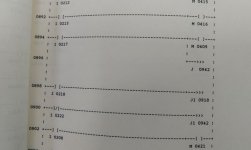Hi all, looking for some help with an old Klockner Moeller PS22 program. I have a hardcopy of a legacy program that is printed out in the Instruction List generated by the S20 software. This is being converted to TwinCAT.
No problems, the code is mostly straight forward except for the JUMP commands. There are several hundred instances of a jump command that I am unsure of, and can't seem to decipher from looking at the surrounding code. The Instruction List command is "JI". Is this an Immediate Jump, or something more cryptic like Inverted Jump? I can find no instances of JN in the code, and the way the JI commands are placed don't make a lot of sense if they are Immediate Jump commands, so I am wondering if this is an older way that Klockner used to indicate a JUMP NOT?
Any help would be greatly appreciated, as finding any documentation on these old PLCs is practically impossible.
No problems, the code is mostly straight forward except for the JUMP commands. There are several hundred instances of a jump command that I am unsure of, and can't seem to decipher from looking at the surrounding code. The Instruction List command is "JI". Is this an Immediate Jump, or something more cryptic like Inverted Jump? I can find no instances of JN in the code, and the way the JI commands are placed don't make a lot of sense if they are Immediate Jump commands, so I am wondering if this is an older way that Klockner used to indicate a JUMP NOT?
Any help would be greatly appreciated, as finding any documentation on these old PLCs is practically impossible.










